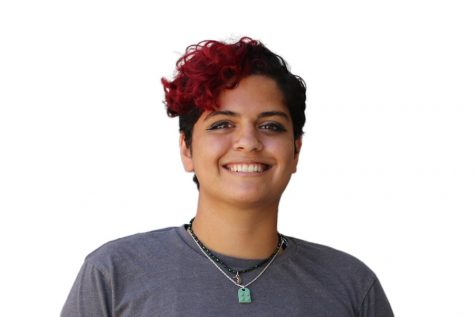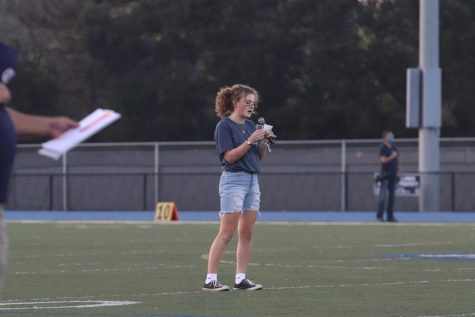

Twitter: @anikamarino04
November 2, 2021
While the Pledge of Allegiance is not required for students, Carlmont still performs the raising of the flag every morning.
Nearly all public schools across the country require daily patriotic exercises, including the schools in California. However, California law does not specify what that patriotic exercise must entail, unlike the 45 states that require the Pledge of Allegiance to be conducted in schools daily.
The Pledge of Allegiance in those 45 states is not required to be conducted by any individual student due to a Supreme Court ruling in 1943 dictating that students themselves could opt out of participating in or standing for the Pledge of Allegiance.
The California High School Graduation Requirements, along with the patriotic exercises requirement, dictates that all high school students must take a full year of American history and geography, along with one semester of American government and civics in order to graduate.
Article 2 of California’s education code, Patriotic Exercises and Instruction, states that “in every public secondary school there shall be conducted daily appropriate patriotic exercises.”
The law also stipulates that every public elementary school must also complete a daily patriotic exercise at the beginning of the first regularly scheduled class or activity period. Article two makes clear that “the giving of the Pledge of Allegiance to the Flag of the United States of America shall satisfy the requirements” of the daily patriotic exercise for both elementary and secondary schools.
The law lists no other specific ways to satisfy this requirement. However, it also does not specify that different methods of meeting this requirement are not permitted.
Carlmont does not require the Pledge of Allegiance to take place every morning; Carlmont’s principal, Ralph Crame, has found a work-around solution to meeting the non-specific daily patriotic exercise requirement.
According to Crame, Carlmont raises the flag every morning at 6:30 a.m. Students are invited to the raising of the flag but are not required to go.
“Anybody’s welcome to come and say the Pledge of Allegiance as the flag goes up. That’s something nobody really does but is also something that’s available to all students,” Crame said.
However, this option is not available for elementary schools due to the requirement that the patriotic exercise must be conducted “each day during the school year at the beginning of the first regularly scheduled class or activity period at which the majority of the pupils of the school normally begin the school day.” Many elementary schools either perform a school-wide Pledge of Allegiance or disregard the law entirely due to a lack of enforcement of the law.

In addition to the requirement for patriotic exercises, the Sequoia Union High School District (SUHSD), has mandated curriculum surrounding the founding documents of the United States such as the Declaration of Independence, Federalist Papers, and the United States Constitution. All of which are part of mandatory reading.
Greer Stone, a history teacher at Carlmont and a Palo Alto City Council member, believes that the documents are essential to American education.
“I think the requirements [of reading certain American documents] make sense because those are foundational documents that every American should know and study and appreciate,” Stone said. “Having that understanding of our history and those foundational principles are the key for any functioning democracy.”
Crame agreed, noting that those documents are an important part of American history.
“I think it’s important that we understand as students what those documents are, how they came about, the reasoning behind them, and how they affect us as a people,” Crame said.
Carlmont mainly integrates these founding documents into senior year with the U.S. Government class; however, the U.S. History course in junior year briefly covers them.
Finally, the SUHSD requires Carlmont to assist students in voter registration and provide appropriate information. According to Crame, voter registration paperwork is given out to seniors in their second semester during their U.S. Economics classes. In previous years, students would also volunteer during elections as poll workers.
Along with this, the SUHSD requires a staff member to be appointed head of voter registration efforts at each high school and “determine the most effective means of distributing voter registration forms provided by the Secretary of State.”
Crame described how the voter registration cards were distributed through Carlmont’s appointed staff member in charge of voter registration efforts, Jayson Waller, head of the history department at Carlmont.
“I get the [voter registration] cards sent to me and I forward them to Mr. Waller. He distributes them out to the [other] teachers to give to our students,” Crame said.
According to Cody Ewert from the University of Montana in his dissertation Lessons in Loyalty: American Patriotism and Education in the Progressive Era, patriotism being a substantial part of American culture holds its roots in the post-Civil War era.
After the Civil War, the Northern and Southern states were highly divided. Organizations like the Grand Army of the Republic (GAR) and the Woman’s Relief Corps (WRC) worked to instill patriotism in the nation and its children. The intent was to try and unify the country directly after a point of the significant political divide.
“Patriotism can act as a tool to be able to bring people together and find these commonalities and focus more on the things that we have in common [rather] than our differences,” Stone said.
The organizations created lesson plans designed to increase schoolchildren’s honor and pride for national symbols. The GAR and WRC also brought flags and symbols into schools to try and achieve this honor and pride.
Following in the footsteps of these organizations, according to the Washington Post, in 1900, Charles Skinner, the Superintendent of Public Instruction for New York, created a manual for patriotism. This manual was meant to be distributed in schools, pushing a similar idea as the GAR and WRC. The book itself has daily guides to significant events in American history and aids children in understanding American values.
The pledge itself came into existence in 1892 as a way of increasing patriotism throughout the United States and has had numerous changes since its conception.
In 1923, the words “my flag” were changed to “the flag of the United States of America” cementing its purpose to specifically increase patriotism in the United States. The words “under God” were also added to the Pledge of Allegiance in 1953 at the start of the Cold War in an attempt to distinguish the United States from “godless Communism.”Additionally, the initial placement of the arm during the pledge resembled that of the Nazi salute, until that gesture became a symbol of the authoritarian regime of Adolf Hitler and the gesture was changed to placing one’s right hand over their heart.
In more recent history, Donald Trump, former president of the United States, issued an executive order to promote further patriotic education, called the 1776 Commission.
During his term as president, Trump put forth the 1776 Commission in an effort to steer school curriculum away from the negatives surrounding the founding of the United States and instead focus on the “exceptional” nature of the United States saying that “the 1776 commission was a dispositive rebuttal of reckless ‘re-education’ attempts that seek to reframe American history around the idea that the United States is not an exceptional country but an evil one.”
On Jan. 20, 2021, President Joe Biden’s first day of office, he issued an executive order to dissolve the 1776 Commission. Biden was backed by a number of historians and experts who dismissed the plans that the 1776 Commission put forth as politically motivated and an attempt to erase and falsify America’s past.
While still technically meeting the requirements put forth by the State of California, Carlmont is lenient in requiring students to perform acts of patriotism, as the school makes no attempt to compel students to recite the Pledge of Allegiance daily.
Molli Shields, a junior, and Ruya Yaman, a senior, agree that the school’s decision to omit the pledge from daily proceedings is not a mistake.
“Having [the Pledge of Allegiance] enforced and especially in educational programs, it gives off the impression that patriotism and one’s education as an American citizen are inherently combined, and they go with each other… I think that’s not a necessary impression to be giving off because they’re two separate things,” Yaman said.
Having [the Pledge of Allegiance] enforced and especially in educational programs, it gives off the impression that patriotism and one’s education as an American citizen are inherently combined
— Ruya Yaman
Shields also voiced that in addition to it not being necessary for American students’ education, some may feel uncomfortable with being compelled to say the Pledge of Allegiance.
“I’m glad we don’t have to say the Pledge of Allegiance because I know plenty of people who, for religious reasons, background reasons, or just their own status in the country don’t enjoy saying the pledge,” Shields said. “I feel that patriotism [in schools] shouldn’t be required, one because the whole [basis to the] founding of America is that everybody’s going to be different, there’s diversity, and everybody’s gonna have their own ideas.”
One way students consistently get involved in patriotism outside of the classroom is in the singing of the National Anthem at large events like football games and assemblies, which Carlmont does participate in.
Shields was one of the students to sing the anthem. However, she questioned why she was made to sing the National Anthem rather than a different song.
“[I did ask], is the National Anthem [a] required song, or can I sing another song like Lift Every Voice and Sing? Because we sing that in choir, and it was a really powerful song and I really enjoyed singing it. The fact that it’s required to sing the National Anthem makes me feel a bit less patriotic,” Shields said.
Neither Shields nor Yaman feel strongly about having a clear sense of daily patriotism within school, and Stone feels very similar.
“I don’t think school is a place where we need to focus on those patriotic duties. Every day is sort of a contrived patriotic exercise that feels very antiquated to me and really unnecessary,” Stone said.
Many students were also not aware that there is a requirement for a daily patriotic exercise in all schools across California.
“I have no problems with the level of patriotism at Carlmont. Teachers usually talk about America in a factual way without giving their own opinions,” said Zachary Leeb, a senior at Carlmont.
None of the students spoken to for this article were aware that they were invited to a daily flag-raising ceremony at 6:30 a.m. for Carlmont to fulfill California law.
One consensus, however, echoed throughout every interview conducted for this article: daily patriotic exercises, especially the Pledge of Allegiance, are not necessary to improve patriotism in American Schools and can sometimes detract from the overall learning environment of a school.

